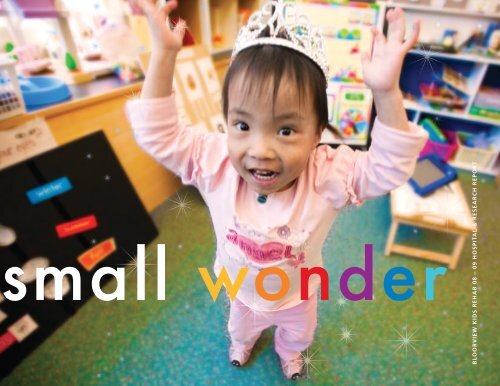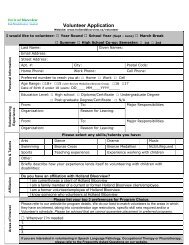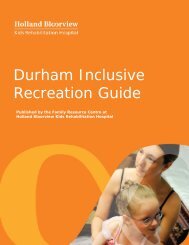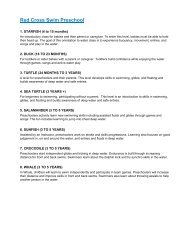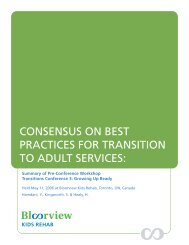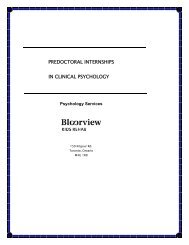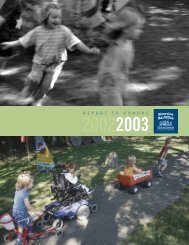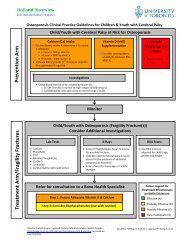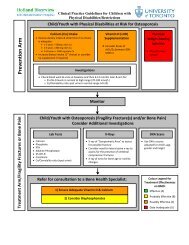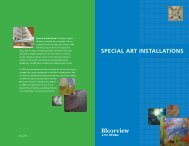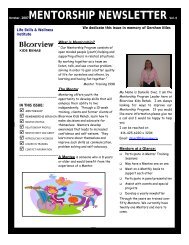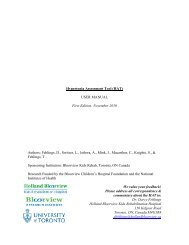View Annual Report Document - Holland Bloorview Kids ...
View Annual Report Document - Holland Bloorview Kids ...
View Annual Report Document - Holland Bloorview Kids ...
Create successful ePaper yourself
Turn your PDF publications into a flip-book with our unique Google optimized e-Paper software.
small wonder<br />
<strong>Bloorview</strong> 2008/09 <strong>Annual</strong> <strong>Report</strong><br />
BLOORVIEW KIDS REHAB 08 – 09 HOSPITAL & RESEARCH REPORT
A world of possibility<br />
For helping us make our<br />
vision a reality, we thank<br />
<strong>Bloorview</strong> <strong>Kids</strong> Foundation,<br />
<strong>Bloorview</strong> Children’s Hospital<br />
Foundation, the Ontario<br />
Ministry of Health and Long-<br />
Term Care, the Toronto<br />
Central Local Health<br />
Integration Network, our<br />
academic partner – the<br />
University of Toronto – and<br />
the many community<br />
agencies who work with us.<br />
We couldn’t do it without you!<br />
<strong>Bloorview</strong> 2008/09 <strong>Annual</strong> <strong>Report</strong>
Dear friends<br />
Wonder.<br />
It’s a spirit that permeates <strong>Bloorview</strong><br />
<strong>Kids</strong> Rehab.<br />
It starts with a deep reverence and<br />
respect for every child, a fascination<br />
with growth and development, and the<br />
belief that all children deserve to<br />
participate fully in life.<br />
It’s the curiosity and imagination that<br />
bring <strong>Bloorview</strong> clinicians and<br />
scientists together to develop<br />
breakthrough treatments and<br />
technologies that improve the lives of<br />
children with disabilities.<br />
Wonder motivates us to question, study<br />
and change a world in which<br />
environments and attitudes too often<br />
exclude children with disabilities.<br />
It opens our eyes to multiple ways of<br />
seeing, and explains the unique<br />
integration of care, research and<br />
education at <strong>Bloorview</strong>.<br />
Wondrous are the deeds of our<br />
volunteers and donors.<br />
We’re pleased to bring you the first<br />
joint report of <strong>Bloorview</strong> <strong>Kids</strong> Rehab<br />
and the <strong>Bloorview</strong> Research Institute.<br />
We call it small wonder because our<br />
focus is children and youth. And while<br />
our size is modest, our work has an<br />
international impact in the field of<br />
childhood disability that’s astonishing.<br />
On many levels, <strong>Bloorview</strong> is truly a<br />
small wonder.<br />
Sheila Jarvis Peter Fullerton Colin Macarthur<br />
President and CEO Chair, Board of Trustees Director, <strong>Bloorview</strong> Research Institute
<strong>Bloorview</strong> big picture<br />
Vision: A world of possibility for kids with disability<br />
STRATEGIC PRIORITIES<br />
•<br />
Establish centres of leadership in child<br />
development and participation<br />
•<br />
Enhance the impact of research<br />
•<br />
Innovate in teaching and learning<br />
•<br />
Create a knowledge hub for<br />
childhood disability<br />
•<br />
Lead system change and integration<br />
and improve access to services<br />
BLOORVIEW RESEARCH 2008-09<br />
Scientists: 19<br />
Trainees: 92<br />
Total external funding:<br />
$4.8 million<br />
Peer-reviewed funded projects: 56<br />
Peer-reviewed publications: 37<br />
Ratio of external to internal funding: 2:1<br />
Peer-reviewed publications per full-time scientist: 3.4<br />
Peer-reviewed grants per full-time scientist: 5.9<br />
Graduate students per full-time scientist: 5<br />
RESEARCH FUNDING BY SOURCE 2008-09<br />
BLOORVIEW KIDS REHAB 2008-09<br />
Outpatient visits: 53,600<br />
Inpatient visits: 644<br />
Average length of stay:<br />
32 days<br />
Total clients: 7,000<br />
Employees: 875<br />
Student doctors, nurses, therapists, teachers,<br />
engineers, psychologists and social workers: 300<br />
Volunteer hours: 44,000<br />
7%<br />
Industry<br />
13%<br />
International<br />
13%<br />
Other national funding agencies<br />
9%<br />
Federal/Provincial<br />
government 5%<br />
7%<br />
Donations<br />
26%<br />
CIHR/NSERC/SSHRC<br />
4%<br />
Other<br />
10%<br />
Provincial funding<br />
agencies<br />
Royalties<br />
6%<br />
Research<br />
endowments
<strong>Bloorview</strong> 2008/09 <strong>Annual</strong> <strong>Report</strong>
In this lab, science is a calling<br />
In February, a study that could unlock<br />
the world of choice to children who<br />
can’t speak or move through optical<br />
brain imaging – a kind of ‘mindreading’<br />
– was published in the Journal<br />
of Neural Engineering and reported<br />
around the world.<br />
It’s no surprise that the study<br />
emanated from Tom Chau’s rehab<br />
engineering lab at <strong>Bloorview</strong>.<br />
The biomedical engineer has a<br />
fundamental belief that guides the<br />
training program he’s built for top<br />
graduate students with scholarships<br />
from around the world.<br />
“Each child is irreplaceable, unique<br />
and precious,” he says.<br />
Given this premise, Tom and his<br />
students are developing body-machine<br />
interfaces to give children who can’t<br />
speak or move a way to communicate<br />
their intentions through brain waves,<br />
breathing patterns and heart rate. The<br />
goal is to translate a child’s physiological<br />
signals into control of a voice-output<br />
device or computer.<br />
‘Each child is irreplaceable,<br />
unique and precious.’<br />
“My students approach their work as<br />
a vocation, not just a degree or job,”<br />
Tom says.<br />
“Vocation comes from the Latin word<br />
‘vocare’ – to call. Applying scientific<br />
skills to create possibilities for children<br />
with disabilities is a personal calling to<br />
each. Many volunteer in other areas of<br />
the hospital. They want to be a living<br />
part of the journey that families take.”<br />
Shining a light, unlocking a mind<br />
In February’s Journal of Neural<br />
Engineering, University of Toronto PhD<br />
student Sheena Luu decodes a person’s<br />
preference for one of two objects with<br />
80 per cent accuracy by measuring the<br />
intensity of near-infrared light<br />
absorbed in brain tissue.<br />
Wearing a headband fitted with fibreoptics<br />
that emit light into the pre-frontal<br />
cortex of the brain, adults were shown<br />
two drinks on a computer monitor, one<br />
after the other, and asked to make a<br />
decision about which they liked more.<br />
“When your brain is active, the oxygen<br />
in your blood increases and depending<br />
on the concentration, it absorbs more<br />
or less light,” Sheena says. She was able<br />
to teach a computer to recognize the<br />
unique pattern of brain activity associated<br />
with preference for each subject.
A child’s best friend<br />
was lift her shoulders off the pillow,”<br />
Kim says. She was receiving nutrition<br />
through a nasal feeding tube and the<br />
trauma of her illness and hospitalization<br />
had left her anxious and withdrawn.<br />
For the next couple of months<br />
Samantha participated in intensive<br />
physical, occupational and speech<br />
therapy and never missed a weekly<br />
pet session.<br />
A brain tumour the size of an apple<br />
turned Kim Burke’s active, exuberant<br />
toddler Samantha into a child she<br />
didn’t recognize.<br />
“First she got lethargic, then she<br />
stopped walking and standing up and<br />
when she crawled, she fell on her face,”<br />
Kim recalls. “By the time we got the<br />
diagnosis, she was barely eating and<br />
limp as a rag doll, lifeless.”<br />
Samantha had surgery to remove the<br />
tumour – which was benign – and<br />
spent two-and-a-half months at<br />
Sick<strong>Kids</strong>. When she came to <strong>Bloorview</strong><br />
for inpatient rehab “all she could do<br />
It wasn’t until Samantha participated<br />
in a pet visiting program at <strong>Bloorview</strong><br />
that Kim says she saw the daughter she<br />
knew return.<br />
“As soon as she saw the dogs, I saw the<br />
sparkle in her eye and the excitement<br />
and the smiles and she started to say<br />
‘doggie’ again, which she’d lost at<br />
Sick<strong>Kids</strong>. When I put her on the<br />
ground, she started bouncing around<br />
like crazy and touching the dogs.<br />
“I can’t even explain in words how<br />
important it was,” Kim says. “It gave<br />
me a sense of hope, of seeing a light at<br />
the end of the tunnel: my daughter was<br />
coming back.”<br />
The pet visiting program is run by<br />
therapeutic recreation and volunteer<br />
resources staff and made possible by 27<br />
volunteers and their dogs and cats.<br />
Samantha’s now eating on her own,<br />
walking with support, cruising on<br />
furniture, “and laughing and chatting<br />
like there’s no tomorrow,” Kim says.<br />
“When we first came to <strong>Bloorview</strong>, I<br />
never could have imagined her doing<br />
so well.”<br />
Wondrous works<br />
Over 1,000 <strong>Bloorview</strong> volunteers<br />
contributed 44,000 hours in 2008-09.<br />
When surveyed, 100 per cent said they<br />
would recommend the experience to<br />
friends and family.
<strong>Bloorview</strong> 2008/09 <strong>Annual</strong> <strong>Report</strong>
A machinist and his magic wand<br />
In January, Sarah Doherty climbed<br />
Africa’s highest peak on high-tech<br />
crutches she developed with <strong>Bloorview</strong><br />
prototypist Bill Johnson.<br />
The 49-year-old lost her right leg at age<br />
13 when she was hit by a drunk driver.<br />
But she never lost her love of the<br />
outdoors and adventure.<br />
Bill machined the crutches with shock<br />
absorbers to make her dream possible.<br />
“They slowly uncoil, like your joints do,<br />
giving a nice cushion in each step,<br />
instead of jarring your joints,”<br />
Sarah says.<br />
He also suggested ball joints in the<br />
attachable feet to mimic the rotation<br />
you get in your ankle.<br />
Bill had used a similar joint in a hockey<br />
stick he designed for a girl with an arm<br />
amputation who wanted to play<br />
Canada’s game. It gave her the multidirectional<br />
movement of a wrist.<br />
‘When they bring their child to<br />
<strong>Bloorview</strong>, they’re going to get<br />
hope and compassion.’<br />
With Bill’s machine-shop wizardry, kids<br />
and adults with disabilities are scaling<br />
their own mountains.<br />
Children with arm prostheses play<br />
baseball, climb rocks and paddle<br />
canoes. One of Bill’s clients, Adrian<br />
Anantawan, is a classical violin soloist.<br />
He was born without a right hand. Bill<br />
designed a metal piece that attaches to<br />
his bow and slides onto a small paddle<br />
he wears on a cuff on his right forearm.<br />
The metal piece acts as a “hand,”<br />
allowing Adrian to hold the bow and<br />
position it on the paddle.<br />
Bill’s work was inspired by another<br />
<strong>Bloorview</strong> client, his sister Anne.<br />
“When my sister was born, the<br />
specialists told my parents ‘she’ll never<br />
amount to anything. Put her in an<br />
institution.’”<br />
With the help of braces, a guide dog<br />
and seizure medication, Anne<br />
graduated from university.<br />
“That’s why I want parents to know<br />
that when they bring their child to<br />
<strong>Bloorview</strong>, they’re going to get hope<br />
and compassion. What I usually say<br />
when I first talk to a client is: “If I had a<br />
magic wand, and could make anything,<br />
what would you like to be able to do?”
The power of one<br />
Who: Vito Bigioni, father to Emily, 13,<br />
who has disabilities, uses a wheelchair<br />
and doesn’t speak. Emily is an artist<br />
who loves to paint and work with clay.<br />
What: Vito’s dream to save <strong>Bloorview</strong>’s<br />
March Break Creative Arts Respite<br />
Camp for children with complex needs.<br />
The program provides a creative, social<br />
and safe environment for Emily while<br />
giving her parents a break from roundthe-clock<br />
care. In 2007 Vito learned the<br />
camp was being cancelled due to a<br />
change in government funding<br />
allocations. Vito, who owns a<br />
construction company, set out to raise<br />
money to ensure its survival.<br />
Why: “I’ve seen changes to other<br />
programs, but I couldn’t swallow this<br />
one. I can’t get that arts programming<br />
in a respite service anywhere. Raising<br />
money gives us a sense of giving back<br />
for what we’ve received from <strong>Bloorview</strong>.<br />
It’s a way of thanking the staff for<br />
running a great program. For Emily’s<br />
brother Max, it’s an important life<br />
lesson. He sees that we’re helping and<br />
that we don’t have to just sit on the<br />
sidelines and take whatever is given to<br />
us. We can be out in the community<br />
and make a difference.”<br />
How: Vito met with <strong>Bloorview</strong> <strong>Kids</strong><br />
Foundation and developed a plan to<br />
raise enough money to keep the<br />
program running for five years –<br />
$250,000. Then he went to family and<br />
business associates to ask them to<br />
support him. Within three months he’d<br />
reached his five-year goal and set a new<br />
target of raising $1 million for the Emily<br />
Bigioni Endowment Fund, to keep the<br />
program going forever. The foundation<br />
provided a personal fundraising page<br />
on its web site; support when Vito<br />
presented to potential donors; and<br />
organized special events, including a<br />
gala reception. Vito has raised over<br />
$750,000 to date.<br />
To find out more, visit<br />
www.bigioni.giftsofpossibility.ca
<strong>Bloorview</strong> 2008/09 <strong>Annual</strong> <strong>Report</strong>
<strong>Bloorview</strong> 2008/09 <strong>Annual</strong> <strong>Report</strong>
Bridging research and clinical care<br />
‘There has to be a constant back and forth – a marriage’<br />
Dr. Evdokia Anagnostou is a child<br />
neurologist and scientist recruited to<br />
<strong>Bloorview</strong> from the Mount Sinai School<br />
of Medicine in New York to develop a<br />
clinical research program in autism.<br />
Evdokia’s clinician scientist position is<br />
a new one that reflects the hospital’s<br />
goal to better bridge the worlds of<br />
research and care.<br />
What brought you to <strong>Bloorview</strong>?<br />
Dr. Anagnostou: There were a number<br />
of pluses to building a clinical research<br />
lab here: access to children with<br />
autism; our link with Sick<strong>Kids</strong>, which<br />
allows me to collaborate with<br />
geneticists and basic scientists; and a<br />
well-organized research institute with<br />
huge potential to grow. I like the<br />
philosophy that disability is where you<br />
start and not where you end. It doesn’t<br />
become who you are, but is just one<br />
aspect of you. That attitude is very<br />
promising for children with autism.<br />
One part of your research focuses on<br />
testing alternative compounds like fish<br />
oil. Why is this important?<br />
Dr. Anagnostou: There are limited<br />
medications available to children with<br />
autism. As a result, parents and<br />
physicians have started using<br />
alternative compounds without any<br />
evidence that they are safe or effective.<br />
We need to test the compounds<br />
scientifically. And because we’ll be<br />
treating many people with autism over<br />
their lifetime, if there are natural<br />
substances that have better safety<br />
profiles than the current drugs we’re<br />
using, we need to know that.<br />
What are the advantages of being a<br />
clinician scientist?<br />
Dr. Anagnostou: The risk, if you’re just a<br />
researcher, is that you get caught up in<br />
asking questions you think you can<br />
answer, instead of what’s relevant and<br />
will have impact for families living with<br />
autism. Seeing children keeps me<br />
grounded in what needs to be asked.<br />
Research keeps us up to date on the<br />
newest treatments. There has to be a<br />
constant back and forth – a marriage –<br />
between the clinical and the research in<br />
order to provide excellent care.<br />
How do you bring a sense of wonder to<br />
your work?<br />
Dr. Anagnostou: My patients bring me a<br />
sense of wonder. What’s special about<br />
children with autism is that their brain<br />
is wired differently, so they have an<br />
alternative view of the world that<br />
challenges our perceptions. They have<br />
the ability to see things from a completely<br />
different view.
Artists visit inpatients at bedside<br />
When children are hospitalized, they’re<br />
cut off from regular activities, friends<br />
and the outside world, and lose a sense<br />
of control.<br />
Not ideal conditions for healing.<br />
So <strong>Bloorview</strong> brings art and gardening<br />
to the bedside to help inpatients<br />
reconnect with their creativity and<br />
the natural world.<br />
Artists and gardeners visit children<br />
one-on-one with trolleys packed with<br />
paints, brushes and clay, baskets of soil<br />
and seeds for planting, cut-flowers,<br />
water and watering cans.<br />
The program is called ARTery because<br />
the art trolley run through the core of<br />
the hospital, restoring children’s<br />
metaphorical hearts.<br />
“It can be transformative,” says Sarah<br />
Dobbs, director of <strong>Bloorview</strong>’s Centre<br />
for the Arts. “It’s an opportunity for the<br />
children to create and contribute again,<br />
and that leads to a sense of wellbeing<br />
and self-esteem.”<br />
“I love it,” says Crystal Brown, 16, who’s<br />
spent half a year in hospital recovering<br />
from surgery to remove a brain tumour.<br />
“On my first day at <strong>Bloorview</strong> I got to<br />
make a wonderful bamboo flute in<br />
ARTery.”<br />
Crystal has spent three months in<br />
inpatient rehab receiving physical,<br />
speech and occupational therapies,<br />
going to school, and choosing a new<br />
hot pink wheelchair.<br />
“ARTery is relaxing and it takes away<br />
stress,” she says – key ingredients in a<br />
hospitalized child’s recovery.
<strong>Bloorview</strong> training draws pediatricians worldwide<br />
University of Toronto’s training program in developmental pediatrics is based at <strong>Bloorview</strong> and prepares<br />
pediatricians to assess and treat children with developmental disabilities as part of a multi-disciplinary rehab<br />
team. The program draws clinical fellows from around the world. We asked a few why they chose <strong>Bloorview</strong>.<br />
“<strong>Bloorview</strong> is a big hospital with a denselypopulated<br />
catchment area, so my chances of<br />
seeing a large volume of patients, which is<br />
very important during a limited, two-year<br />
fellowship, were better. The academic and<br />
research parts of the program are excellent.”<br />
“As a pediatrician, I’m trained to know<br />
concrete pathology. But kids with<br />
disabilities are so intricate. No two are<br />
the same. You can’t learn about them in<br />
a textbook or in medical school. You<br />
need hands-on interaction in a rehab<br />
hospital like <strong>Bloorview</strong>.”<br />
Dr. Sharon Smile<br />
Kingston, Jamaica<br />
Dr. Michal Begin<br />
Jerusalem, Israel
“Canada has an excellent reputation<br />
internationally for training doctors in<br />
many specialties. The developmental<br />
pediatrics program at <strong>Bloorview</strong> is one<br />
of the few programs that offer training in<br />
neurodevelopment anywhere in the<br />
world. I was unable to find such a<br />
training program in Ireland or Britain,<br />
where I had previously trained.”<br />
“<strong>Bloorview</strong>’s developmental pediatrics<br />
program has many renowned experts in<br />
developmental and behavioural fields,<br />
especially in autism and cerebral palsy at<br />
<strong>Bloorview</strong>, and neurology at Sick<strong>Kids</strong>. The<br />
program gave me rich experiences in<br />
clinical, research and academic activities.<br />
I learned a lot in the area of autism and<br />
how to assess children with unique tools.<br />
That’s been very useful when I returned<br />
to my country.”<br />
Dr. Kay Lekagul<br />
Bangkok, Thailand<br />
Dr. Siobhan Gallagher<br />
Limerick, Ireland
Building the case for Botox, step by step<br />
Like any five-year-old, Chantel Azevedo<br />
likes to be on the move.<br />
But until recently, getting around was<br />
difficult. That’s because cerebral palsy<br />
made her right leg muscles stiff, pulling<br />
her heel off the floor. “You can imagine<br />
how hard it would be to walk everywhere<br />
on tip-toe,” her mom Vicky says. “It<br />
knocked her balance off and made<br />
her fall.”<br />
That changed dramatically when<br />
Chantel had Botox injections to treat<br />
the stiffness – known as spasticity – at<br />
<strong>Bloorview</strong>. “She was able to put her foot<br />
flat on the ground, which meant she<br />
could walk and run better, play jumprope<br />
better, alternate her legs climbing<br />
stairs, and do all the things five-yearolds<br />
like to do.”<br />
<strong>Bloorview</strong> was one of the first hospitals<br />
in North America to use Botox to treat<br />
spasticity in children, conducted one of<br />
the first randomized trials to show its<br />
efficacy, and uses the treatment in over<br />
400 children each year. The drug<br />
temporarily blocks abnormal brain<br />
signals that cause muscles to contract.<br />
Dr. Darcy Fehlings, physician director<br />
of <strong>Bloorview</strong>’s child development<br />
program and head of the University of<br />
Toronto Division of Developmental<br />
Pediatrics, has just embarked on the<br />
first study to look at the long-term<br />
impact of Botox on motor function and<br />
participation.<br />
“We want to see if the short-term gains<br />
we see in function translate into a<br />
richer, everyday quality of life over the<br />
long-term,” says Darcy. “Are kids able<br />
to take more steps, participate in more<br />
recreation activities, and move around<br />
in the community more easily?”<br />
About 180 children, aged two to five,<br />
will be followed over three years.<br />
Dr. Darcy Fehlings is part of an<br />
international group of specialists who<br />
developed a consensus statement on<br />
the medical uses of botulinum toxin<br />
based on an extensive review of the<br />
scientific literature. Findings of the<br />
review on treating upper-limb<br />
spasticity in children – which Darcy led<br />
– will be published in the European<br />
Journal of Neurology.
Access study looks to kids as experts<br />
The challenge: Participating in everyday<br />
activities helps children develop skills,<br />
interests and friendships that promote<br />
physical health and emotional<br />
wellbeing. But children who use<br />
wheelchairs or walkers face barriers.<br />
That’s because most houses,<br />
communities and schools aren’t built<br />
with their needs in mind. Stairs, narrow<br />
doorways and standard furniture<br />
separate these kids from their peers.<br />
Sometimes buildings are technically<br />
accessible, but convey the message that<br />
children with disabilities don’t belong.<br />
For example, a ramp may be added to a<br />
school, but if it's located at the back of<br />
the building and everyone else goes in<br />
at the front, it implies second-class<br />
treatment. Little is known about how<br />
children with disabilities navigate and<br />
evaluate their built environments.<br />
The solution: A three-year study led by<br />
<strong>Bloorview</strong> scientist Patricia McKeever<br />
asks children to rate the accessibility<br />
and inclusiveness of their homes,<br />
communities and schools.<br />
How it works: In the first phase –<br />
underway now – 12 children aged 10-14<br />
from urban, suburban, rural and<br />
northern Ontario communities are<br />
interviewed about each environment.<br />
<strong>Kids</strong> draw maps on a tablet PC, take<br />
photos and talk about how they get<br />
around and how included they feel in<br />
each setting. Outside, they carry a<br />
blackberry that generates a real-time<br />
map of their whereabouts. Later, using<br />
Google Earth, they discuss the places<br />
they went, barriers faced and what<br />
could be improved. Researchers assess<br />
five locations chosen by the child,<br />
including a nearby park, movie theatre,<br />
restaurant, doctor’s office and store.<br />
Based on case study findings, a survey<br />
of about 1,000 Ontario children aged<br />
six to 14 will be conducted in the fall.<br />
The impact: The goal is to develop<br />
scientific evidence that will influence<br />
building codes and place-based<br />
interventions so that kids with<br />
disabilities have the same<br />
opportunities as their peers to<br />
participate in childhood activities.
Making the system work<br />
Making it easier for children and<br />
families to obtain services by<br />
partnering with other players in the<br />
health system is a strategic priority<br />
for <strong>Bloorview</strong>.<br />
2008 was a banner year for<br />
partnerships and collaboration that<br />
improved the speed at which children<br />
and youth received inpatient<br />
rehabilitation care and services for<br />
children diagnosed with autism.<br />
Speeding transition to<br />
inpatient rehab<br />
Problem: Children with brain injuries<br />
who were ready to be transferred to<br />
<strong>Bloorview</strong> for inpatient rehab spent on<br />
average nine days more than needed<br />
in Sick<strong>Kids</strong>’ trauma unit in 2006. A<br />
cumbersome <strong>Bloorview</strong> referral form<br />
was identified as the challenge, causing<br />
273 medically-unnecessary days.<br />
Partnership: Managers and frontline<br />
staff at <strong>Bloorview</strong> and Sick<strong>Kids</strong> worked<br />
together to simplify and improve the<br />
referral process, as part of the Ontario<br />
Health Ministry’s Flo Collaborative.<br />
Solution: A new, concise two-page<br />
referral form. What originally took four<br />
people three days to complete can now<br />
be filled out by one person in an hour.<br />
An up-to-date clinical overview is sent<br />
48 hours before transfer. Staff agreed on<br />
common definitions of “medicallystable<br />
and rehab-ready.” Visual icons<br />
that describe steps in the referral<br />
process were developed and are posted<br />
beside the child’s name on an<br />
information board at Sick<strong>Kids</strong>. This<br />
helps staff identify what stage the child<br />
is at and minimizes duplication of tasks.<br />
Impact: Unnecessary days were cut<br />
from nine to three, and incomplete<br />
referral forms from 50 per cent to less<br />
than five per cent. <strong>Bloorview</strong> is using<br />
the process-improvement knowledge it<br />
gained to improve referral practices on<br />
other units.
Linking families to<br />
autism services<br />
Problem: Over 100 children are<br />
diagnosed with autism at <strong>Bloorview</strong><br />
each year. For ongoing treatment, we<br />
refer families to agencies like the<br />
Geneva Centre for Autism. In 2006-07,<br />
only 63 per cent of the families<br />
diagnosed successfully made the<br />
transition. Community services for<br />
autism are complicated and can be<br />
difficult for families to access.<br />
Partnership: <strong>Bloorview</strong> and the<br />
Geneva Centre partnered to ensure<br />
families make the transition from<br />
one organization to the other<br />
and get the services their<br />
children need.<br />
Solution: A new social work position<br />
was created to ensure families are<br />
successfully bridged from <strong>Bloorview</strong> to<br />
the Geneva Centre. The social worker<br />
meets with parents to discuss their<br />
goals, initiates the referral, explains<br />
services available at Geneva and<br />
elsewhere in the community, and<br />
provides emotional support.<br />
Impact: In 2007-08, 86 per cent of<br />
children diagnosed with autism at<br />
<strong>Bloorview</strong> were bridged to the Geneva<br />
Centre. In 2008-09 it was 87 per cent.<br />
The Impact on Family Scale – which<br />
measures the impact of a child’s<br />
disability on the family – shows an<br />
overall decrease in family stress<br />
following transfer to the Geneva<br />
Centre.
The wonder year<br />
BLOORVIEW BUILDS RESEARCH TALENT<br />
BLOORVIEW SHEDS LIGHT ON HOUSING<br />
FUNDING TARGETS SOCIAL INCLUSION u<br />
<strong>Bloorview</strong> recruited five top clinical<br />
and social scientists to build our<br />
leadership in participation and child<br />
development programs. Two positions<br />
combine clinical and research work<br />
and reflect our plan to more closely<br />
integrate research, clinical and<br />
teaching efforts.<br />
<strong>Bloorview</strong> submitted a report to the<br />
City of Toronto – which is developing a<br />
10-year affordable housing plan –<br />
outlining the challenges families of<br />
children with disabilities face in finding<br />
accessible and affordable housing. We<br />
were delighted that the City<br />
subsequently identified families with<br />
children with disabilities as a priority<br />
group for new affordable housing.<br />
Almost $4 million in funding for<br />
childhood disability research was<br />
announced by the federal government<br />
at <strong>Bloorview</strong>. Five teams of Canadian<br />
scientists will conduct research to<br />
improve the social inclusion and<br />
participation of children with severe<br />
disabilities. The funding is a partnership<br />
between the Canadian Institutes of<br />
Health Research and <strong>Bloorview</strong><br />
Children’s Hospital Foundation.
t EARLY RESEARCHER AWARDS<br />
SHEILA JARVIS LEADS MISSION TO CHINA<br />
Ontario Research and Innovation<br />
Minister John Wilkinson announced<br />
funding of 22 Toronto research projects<br />
worth over $3 million through the Early<br />
Researcher Awards program at<br />
<strong>Bloorview</strong>. Tom Chau, who leads a team<br />
of scientists developing assistive<br />
technologies at <strong>Bloorview</strong>, was one of<br />
the recipients. “We don’t have to look<br />
any further than <strong>Bloorview</strong> to find<br />
extraordinary examples of inspirational<br />
and pioneering innovators,” Minister<br />
Wilkinson said.<br />
<strong>Bloorview</strong> President and CEO Sheila<br />
Jarvis represented the Council of<br />
Academic Hospitals of Ontario on a<br />
visit to China to pursue health research<br />
partnerships between China and<br />
Ontario. Universities in Hong Kong,<br />
Shanghai and Beijing are keen to<br />
explore joint grant applications,<br />
research projects and publications, and<br />
exchange of post-doctoral students.<br />
<strong>Bloorview</strong> will host two students this<br />
summer. Next steps include a scientific<br />
symposium in Ontario.<br />
NEW TAX-FREE SAVINGS PLAN<br />
CANADA’S CHEFS SHARE SECRETS<br />
Canada’s new Registered Disability<br />
Savings Plan was launched by Minister<br />
of Finance Jim Flaherty and Minister<br />
of Human Resources and Skills<br />
Development Diane Finley at <strong>Bloorview</strong>.<br />
The plan is a tax-free option to help<br />
parents save for the long-term needs of<br />
children with severe disabilities.<br />
A gala dinner to launch the third<br />
annual Recipes for Possibility Calendar<br />
drew over 200 business and community<br />
leaders and raised more than $425,000<br />
for <strong>Bloorview</strong>. The calendar features<br />
recipes from 13 of Canada’s top chefs,<br />
and was sponsored by BMO Financial<br />
Group.
No wonder we’re the best!<br />
W hy do you work at <strong>Bloorview</strong>?<br />
“I have a sister with special needs who<br />
has greatly inspired me to work in the<br />
field of disability. I did my masters<br />
placement at <strong>Bloorview</strong> and after<br />
meeting the fabulous staff and social<br />
work colleagues, I was hooked. It was<br />
my dream to work here and here I am!”<br />
Stephanie Willison<br />
Social Worker<br />
Complex Continuing Care,<br />
Family Support Services<br />
“Because of the children and families.<br />
We have to find ways to understand the<br />
causes of autism and we have to find<br />
better ways to provide integrated and<br />
comprehensive care that relieves the<br />
burden and stressors for caregivers and<br />
kids. It's listening to what parents are<br />
struggling with everyday that keeps us<br />
going in trying to make changes.”<br />
Dr. Wendy Roberts<br />
Developmental Pediatrician<br />
Child Development Program<br />
“I love working at the <strong>Bloorview</strong> School<br />
because every day is a great<br />
adventure.”<br />
Paul Alcamo<br />
Teacher<br />
Integrated Kindergarten Program
“I like my job. I have fun meeting<br />
different people from all cultures. I like<br />
to be friendly with everyone.”<br />
Maggie Rodrigues<br />
Dietary Aid,<br />
Cafeteria<br />
“I want to make a difference in<br />
children’s lives. The children at<br />
<strong>Bloorview</strong> inspire me in all realms of<br />
my life. <strong>Bloorview</strong> has a friendly<br />
atmosphere that always makes me feel<br />
welcome.”<br />
Jorge Santos<br />
Registered Nurse<br />
Complex Continuing Care<br />
“It’s nice to have a workplace that is so<br />
aligned with my personal values. I feel<br />
great about the work I do everyday,<br />
even though I’m not on the front lines.”<br />
Kathy Foisey<br />
Executive Assistant<br />
Human Resources
In case you wondered<br />
Peer-Reviewed Publications<br />
Alves N, Chau T. Testing the<br />
Stationarity of Mechanomyographic<br />
Signals from Extrinsic Hand<br />
Muscles During Isometric<br />
Contractions. Journal of<br />
Electromyography and<br />
Kinesiology 2008;18(3):509-515.<br />
Alves N, Chau T. Vision-based<br />
Segmentation of Continuous<br />
Mechanomyographic Grasping<br />
Sequences for Training<br />
Multifunction Prostheses. IEEE<br />
Transactions on Biomedical<br />
Engineering 2008;55(2):765-773.<br />
Andrysek J, Redekop S, Matsui N,<br />
Kooy J, Hubbard S. A method to<br />
measure the accuracy of loads in<br />
knee-ankle-foot orthoses using<br />
conventional gait analysis, applied<br />
to persons with poliomyelitis.<br />
Arch Phys Med Rehabil<br />
2008;89(7):1372-79.<br />
Biddiss E, Chau T. Dielectric<br />
elastomers as actuators for upper<br />
limb prosthetics: challenges and<br />
opportunities. Medical<br />
Engineering & Physics<br />
2008;30(4):403-418.<br />
Biddiss E, Chau T. Multivariate<br />
modeling for prediction of<br />
prosthesis use or rejection.<br />
Disability and Rehabilitation.<br />
Assistive Technology<br />
2008;3(4):181-192.<br />
Blain S, Chau T, Mihailidis A.<br />
Body language: the untapped<br />
potential of the autonomic<br />
nervous system. Open<br />
Rehabilitation 2008;1:27-37.<br />
Blain S, Mihailidis A, Chau T.<br />
Assessing the potential of<br />
electrodermal activity as an<br />
alternative access pathway.<br />
Medical Engineering & Physics<br />
2008;30(4):509-515.<br />
Brian JA, Bryson SE, Garon N,<br />
Roberts W, Smith I, Szatmari P,<br />
Zwaigenbaum L. Clinical<br />
assessment of autism in high-risk<br />
18 month olds. Autism<br />
2008;12(5):433-456.<br />
Brooks D, Gibson BE, Dematteo<br />
D. Perspectives of Personal<br />
Support Workers and Ventilator-<br />
Users on Training Needs. Patient<br />
Education and Counseling<br />
2008;71:244-250.<br />
Carnevale FA, Macdonald ME,<br />
Bluebond-Langner M, McKeever<br />
P. Using Participant Observation<br />
in Pediatric Health Care Settings:<br />
Ethical Challenges and Solutions.<br />
Journal of Child Health Care<br />
2008;12(1):18-32.<br />
DeMatteo CA, Cousins MA, Lin<br />
CY, Law MC, Colantonio AC,<br />
Macarthur C. Post- injury living<br />
environments for children and<br />
youth with acquired brain injury.<br />
Arch Phys Med Rehabil<br />
2008;89:1803-10.<br />
Di Rezze B, Wright FV, Curran CJ,<br />
Campbell K, Macarthur C.<br />
Individualized outcome measures<br />
for evaluating life skill groups for<br />
children with disabilities. Can J<br />
Occup Ther 2008;5:282-287.<br />
Epstein I, Stevens S, McKeever P,<br />
Baruchel S. Using a puppet to<br />
elicit talk with children. Nursing<br />
Inquiry 2008;15(1):49-56.<br />
Fernandes D, Chau T. Fractal<br />
dimension of pacing and grip<br />
force in handwriting stroke<br />
production. Journal of<br />
Biomechanics 2008;41:40-46.<br />
Gibbins S, Stevens S, McGrath P,<br />
Yamada J, Beyene J, Breau L,<br />
Camfield C, Finley A, Franck L,<br />
Johnston C, Howlett A, McKeever<br />
P, O’Brien K, Ohlsson A.<br />
Comparison of pain responses in<br />
infants of different gestational<br />
ages. Neonatology 2008;93:10-18.<br />
Guerriere D, Wong A, Croxford R,<br />
Leong V, McKeever P, Coyte P.<br />
Costs and determinants of<br />
privately-financed home-based<br />
health care in Ontario, Canada.<br />
Health and Social Care in the<br />
Community 2008;16(2):126-136.<br />
Guiqing C, Edelmann L,<br />
Goldsmith JE, Cohen N,<br />
Nakamine A, Reichert JG,<br />
Hoffman EJ, Zurawiechi DAM,<br />
Silverman JM, <strong>Holland</strong>er E,<br />
Soorya L, Anagnostou E,<br />
Betancur C, Buxbaum JD.<br />
Multiplex ligation-dependent<br />
probe amplification for genetic<br />
screening in autism spectrum<br />
disorders: efficient identification<br />
of known microduplications and<br />
identification of a novel<br />
microduplication in ASMT.<br />
Medical Genomics 2008;16:1-50.
King G, Bartlett D, Currie M,<br />
Gilpin M, Baxter D, Willoughby C,<br />
Tucker MA, Strachan D.<br />
Measuring the expertise of<br />
pediatric rehabilitation therapists.<br />
International Journal of Disability,<br />
Development and Education<br />
2008;55(1):5-26.<br />
King G, Batorowicz B, Shepherd<br />
TA. Expertise in researchinformed<br />
clinical decision<br />
making: Working effectively with<br />
families of children with little or<br />
no functional speech. Evidence-<br />
Based Communication<br />
Assessment and Intervention<br />
2008;2(2):106-116.<br />
King G, Currie M, Smith L, Servais<br />
M, McDougall J. A framework<br />
of operating models for<br />
interdisciplinary research<br />
programs in clinical service<br />
organizations. Evaluation and<br />
Program Planning 2008;31:160-173.<br />
Kolski HK, Hawkins C, Zatz M, de<br />
Flavia P, Biggar WD, Alman B,<br />
Vajsar J. Diagnosis of limb-girdle<br />
muscular dystrophy 2A by<br />
immunohistochemical<br />
techniques. Neuropathology<br />
2008;28(3):264-268.<br />
Lee J, Steele C, Chau T. Time and<br />
Time-Frequency Characterization<br />
of Dual-Axis Swallowing<br />
Accelerometry Signals.<br />
Physiological Measurement<br />
2008;29(9):1105-1120.<br />
Missiuna C, Moll S, King G,<br />
Stewart D, Macdonald K. Life<br />
experiences of young adults who<br />
have coordination difficulties.<br />
Canadian Journal of Occupational<br />
Therapy 2008;75(3):157-166.<br />
Murphy A, Milo-Manson G, Best<br />
A, Campbell K, Fehlings D. The<br />
impact of modafinil on spasticity<br />
reduction and quality of life in<br />
children with cerebral palsy.<br />
Developmental Medicine and<br />
Child Neurology 2008;50:510-514.<br />
Narayanan U. Multiple<br />
Collaborators from American<br />
Academy of Pediatrics<br />
Orthopaedic Section and Pediatric<br />
Orthopaedic Society of North<br />
America: Management of<br />
Pediatric Trauma. Pediatrics<br />
2008;121(4):849-54.<br />
Redekop S, Andrysek J, Wright V.<br />
Single-Session Reliability of<br />
Discrete Gait Parameters in<br />
Ambulatory Children with<br />
Cerebral Palsy based on GMFCS<br />
level. Gait Posture 2008;28(4):627-33.<br />
Silva J, Torres J, Chau T, Mihailidis<br />
A. A novel asynchronous access<br />
method with binary interfaces.<br />
Journal of Neuroengineering and<br />
Rehabilitation 2008;5:24.<br />
Stevens B, McGrath P, Dupuis A,<br />
Gibbins S, Beyene J, Breau L,<br />
Camfield C, Finley A, Franck L,<br />
Howlett A, Johnston C, McKeever<br />
P, O’Brien K, Ohlsson A, Yamada J.<br />
Indicators of pain in neonates at<br />
risk for neurological impairment.<br />
Journal of Advanced Nursing<br />
2008;65(2):285-296.<br />
Tai K, Blain S, Chau T. A review of<br />
emerging access technologies for<br />
individuals with severe motor<br />
impairments. Assistive<br />
Technology 2008;20:204-219.<br />
Tam C, Teachman G, Wright V.<br />
Pediatric Application of<br />
Individualized Client-Centered<br />
Outcome Measures: A Literature<br />
Review. British Journal of<br />
Occupational Therapy<br />
2008;71(7):286-296.<br />
Thompson P, Beath T, Bell J,<br />
Jacobson G, Phair T, Salbach NM,<br />
Wright FV. Test-retest reliability of<br />
the 10-metre fast walk test and<br />
6-minute walk test in ambulatory<br />
school-aged children with<br />
cerebral palsy. Dev Med Child<br />
Neurol 2008;50:370-376.<br />
Wiles R, Cott C, Gibson BE.<br />
Understanding hope and illness:<br />
A narrative literature review of<br />
qualitative research on hope,<br />
expectations and recovery, Journal<br />
of Advanced Nursing<br />
2008;64(6):564-573.<br />
Wright JG, Smith PL, Owen JL,<br />
Fehlings DL. Assessing functional<br />
outcomes of children with<br />
muscular dystrophy and scoliosis:<br />
the muscular dystrophy spine<br />
questionnaire. Journal of<br />
Pediatric Orthopaedics<br />
2008;28(8):840-845.<br />
Wright JG, Smith PL, Owen JL,<br />
Fehlings DL. Simple Bone Cyst<br />
Trial Group: A randomized clinical
trial comparing intralesional bone<br />
marrow and steroid injections for<br />
simple bone cysts. The Journal of<br />
Bone & Joint Surgery (A)<br />
2008;90(4):722-30.<br />
Wright V, Rosenbaum P,<br />
Goldsmith C, Fehlings D, Law M.<br />
How do changes in body<br />
functions/structures, activity and<br />
participation relate to each other<br />
in children with cerebral palsy.<br />
Dev Med Child Neurol<br />
2008;50:283-289.<br />
Young S, Pratt J, Chau T. Choosing<br />
the fastest movement: perceiving<br />
speedaccuracy tradeoffs.<br />
Experimental Brain Research<br />
2008;185(4):681-688.<br />
Zabjek KF, Leroux MA, Coillard C,<br />
Prince F, Rivard CH. Postural<br />
characteristics of adolescents with<br />
idiopathic scoliosis. J Pediatric<br />
Orthop 2008;28(2):218-24.<br />
Peer-Reviewed Funding<br />
fMRI for the study of response<br />
inhibition, and face and linguistic<br />
processing in autism, Seaver<br />
Foundation, (2 Years), $28,687,<br />
Anagnostou, E (PI)<br />
fMRI study of the effect of<br />
intravenous oxytocin vs placebo<br />
on response inhibition and face<br />
processing in autism, Seaver<br />
Foundation, (3 Years), $10,625,<br />
Anagnostou, E (PI)<br />
A double blind placebo controlled<br />
trial of memantine targeting<br />
motor skills in autism, Autism<br />
Speaks, (2 Years), $54,493,<br />
Anagnostou, E (Co-PI)<br />
Brain glutamate concentrations in<br />
autistic adolescents by magnetic<br />
resonance spectroscopy,<br />
NARSAD - Young Investigator<br />
Award, (2 Years), $30,000,<br />
Anagnostou, E (PI)<br />
Brain glutamate concentrations in<br />
autistic children by magnetic<br />
resonance spectroscopy, Autism<br />
Speaks, (2 Years), $54,791,<br />
Anagnostou, E (PI)<br />
Clinical trial network;<br />
infrastructure grant to do multisite<br />
pilot studies in autism, Autism<br />
Speaks, (3 Years), $114,483,<br />
Anagnostou, E (PI)<br />
Refinement of prototype for<br />
self-energizing prosthetic knee<br />
damper, Ontario Centers of<br />
Excellence CCIT Market<br />
Readiness, (1 Year), $50,000,<br />
Andrysek, J (PI)<br />
Further development of a<br />
stance-phase controlled kneeankle-foot-orthotic,<br />
Proof of<br />
Principle Fund of the Ontario<br />
Research Commercialization<br />
Program (ORCP - POP), (1 Year),<br />
$50,000, Andrysek, J (PI)<br />
Swing-phase controller for a lowcost<br />
prosthetic knee joint, Proof of<br />
Principle Fund of the Ontario<br />
Research Commercialization<br />
Program (ORCP - POP), (1 Year),<br />
$49,000, Andrysek, J (PI)<br />
Effect of the Wii Fit video game as<br />
a therapeutic intervention in<br />
promoting dynamic balancecontrol<br />
among paediatric<br />
amputees, <strong>Bloorview</strong> Research<br />
Institute Seed Grant Competition,<br />
(1 Year), $24,525, Andrysek, J (Co-PI)<br />
Design of a Novel, User-centred<br />
Prosthetic Sleeve, Medicork Ltd.,<br />
(1 Year), $21,000, Biddiss, E (PI)<br />
Longitudinal study of the<br />
relationship between impairment,<br />
activity limitation, participation<br />
and quality of life in persons with<br />
Duchenne muscular dystrophy- a<br />
five-year study, CINRG, (5 Years),<br />
$8,395, Biggar, D (PI)<br />
Enhancing Inter-subjectivity in<br />
Infants at High-Risk for Autism,<br />
Autism Speaks Canada, (3 Years),<br />
$212,668, Brian, J (Co-PI)<br />
Canada Research Chair in<br />
Intelligent Systems in<br />
Multidisciplinary Paediatric<br />
Rehabilitation, Canada Research<br />
Chairs, (5 Years), $143,500,<br />
Chau, T (PI)<br />
Intelligent systems in paediatric<br />
rehabilitation, Natural Sciences<br />
and Engineering Research<br />
Council, Discovery Grants-<br />
Individual, (5 Years), $31,768,<br />
Chau, T (PI)
Combining musical training<br />
through VMI and Smart <strong>Kids</strong><br />
Learning Software, Ministry of<br />
Research and Innovation, Ontario<br />
Research Commercialization<br />
Program, (1 Year), $50,000,<br />
Chau, T (PI)<br />
Advanced body-machine<br />
interfaces for voiceless<br />
communications, Principal<br />
Investigator (with E. Bouffet and<br />
Panacis Medical) Ontario Centres<br />
of Excellence, Biomedical<br />
Collaborative Research Program,<br />
(3 Years), $80,000, Chau, T (PI)<br />
“Body talk”: access technologies<br />
for voiceless communication and<br />
interaction, Ministry of Research<br />
and Innovation, Early Researcher<br />
Award, (5 Years), $38,000, Chau, T (PI)<br />
Development of a proof-ofconcept<br />
medical device: the<br />
aspirometer, Ministry of Research<br />
and Innovation, Ontario Research<br />
Commercialization Program, (1<br />
Year), $50,000, Chau, T (PI)<br />
Development of a commercial<br />
prototype of a device to assist<br />
aspiration detection, Precarn,<br />
Small Company Research<br />
Program, (1 Year), $276,770,<br />
Chau, T (Co-PI)<br />
Access innovations for individuals<br />
without a voice, REMAD<br />
Foundation (Hong Kong),<br />
Operating Grants for Scientists of<br />
Chinese Descent, (3 Years),<br />
$50,000, Chau, T (PI)<br />
An Evaluation of the Long-term<br />
Effectiveness of Botulinum Toxin<br />
in Children with Spastic Cerebral<br />
Palsy, CIHR, (4 Years), $106,489,<br />
Fehlings, D (PI)<br />
Cerebral Palsy Outcomes Project<br />
(CPOP), American Academy for<br />
Cerebral Palsy and Developmental<br />
Medicine, (1 Year), $25,000,<br />
Fehlings, D (PI)<br />
There’s no place like home: What<br />
constitutes an “adequate” home<br />
environment for younger disabled<br />
adults? CIHR Catalyst Grant:<br />
Ethics, (2 Years), $46,072,<br />
Gibson, B (Co-PI)<br />
Assessment of Children’s Capacity<br />
to Consent for Research: A<br />
Descriptive Qualitative Pilot Study<br />
of Researchers’ Practices and<br />
REBs’ Expectations, <strong>Bloorview</strong><br />
Research Institute Seed Grant,<br />
(1 Year), $24,926, Gibson, B (PI)<br />
WALK: Why Ambulation Learning<br />
for <strong>Kids</strong>? Social Science and<br />
Humanities Research Council<br />
(SSHRC) Research Development<br />
Initiatives, (1 Year), $35,351,<br />
Gibson, B (PI)<br />
School role participation:<br />
Perspectives of the child, the<br />
parents, and the teachers, Social<br />
Sciences and Humanities<br />
Research Council of Canada, (3<br />
Years), $36,666, King, G (Co-PI)<br />
Facilitating the development of<br />
professional expertise in<br />
children’s mental health,<br />
rehabilitation, and education<br />
services, Social Sciences and<br />
Humanities Research Council of<br />
Canada, (1 Year), $18,210, King, G (PI)<br />
Inclusion in the environments<br />
and activities of childhood: A<br />
focus on optimal environments<br />
and the experience of meaningful<br />
participation, Canadian Institutes<br />
of Health Research, (1 Year),<br />
$9,937, King, G (PI)<br />
An evaluation of an occupational<br />
therapy mentorship program:<br />
Effects on therapists’ skills and<br />
family-centred behaviour,<br />
<strong>Bloorview</strong> Research Institute Seed<br />
Grant Competition, (1 Year),<br />
$24,783, King, G (PI)<br />
Facilitating optimal life<br />
experiences and environments for<br />
children with disabilities and their<br />
families, Ontario Mental Health<br />
Foundation, (3 Years),<br />
$29,840, King, G (PI)<br />
Communication competencies in<br />
children who use augmentative<br />
and alternative communication<br />
(AAC): A multi-site and crosscultural<br />
investigation, Ontario<br />
Federation for Cerebral Palsy, (1<br />
Year), $39,648, King, G (Co-PI)<br />
From Knowledge Generation to<br />
Knowledge Translation: A Systems<br />
Approach to Reducing the Burden<br />
of Injury in Canada, Canadian<br />
Institutes of Health Research,<br />
(5 Years), $188,472, Macarthur, C (PI)
A longitudinal evaluation of The<br />
LIFEspan Model of linked<br />
healthcare, Ontario Neurotrauma<br />
Foundation, (4 Years), $76,750,<br />
Macarthur, C (Co-PI)<br />
Outcomes Research in Paediatrics,<br />
Hospital for Sick Children<br />
Foundation, (5 Years), $150,000,<br />
Macarthur, C (Co-PI)<br />
The Lived Experiences of Mothers<br />
of Children with Autism, Social<br />
Sciences and Humanities<br />
Research Council of Canada, (3<br />
Years), $18,000, McKeever, P (Co-PI)<br />
School, Home and<br />
Neighbourhood Accessibility:<br />
Physically Disabled Children’s<br />
Assessments (The ScHaN Project),<br />
Canadian Institutes of Health<br />
Research, (3 Years), $120,256,<br />
McKeever, P (PI)<br />
The Lived Experiences of Mothers<br />
of Children with Autism, The<br />
Hospital for Sick Children<br />
Foundation, (2 Years), $64,910,<br />
McKeever, P (Co-PI)<br />
Identity, Embodiment and Heart<br />
Transplantation: A<br />
Phenomenologically-Informed<br />
Exploration, Advanced Heart<br />
Failure Fund, University Health<br />
Network, (1 Year), $75,000,<br />
McKeever, P (Co-PI)<br />
From fixing to function: exploring<br />
opportunities for the<br />
development of a functional<br />
optimization model for<br />
intervention for children with<br />
disabilities, Social Sciences and<br />
Humanities Research Council of<br />
Canada (SSHRC), (1 Year),<br />
$10,000, Narayanan, U (Co-PI)<br />
Functional Outcomes Following<br />
Orthopaedic Surgery Based On<br />
Gait Laboratory Versus<br />
Observational Gait Analysis In<br />
Ambulatory Children With<br />
Cerebral Palsy: A Randomized<br />
Controlled Trial, Zimmer of<br />
Canada, (2 Years), $4,250,<br />
Narayanan, U (PI)<br />
Functional Outcomes Following<br />
Orthopaedic Surgery Based On<br />
Gait Laboratory Versus<br />
Observational Gait Analysis In<br />
Ambulatory Children With<br />
Cerebral Palsy: A Randomized<br />
Controlled Trial, Pediatric<br />
Orthopaedic Society of North<br />
America (POSNA), (2 Years),<br />
$15,500, Narayanan, U (PI)<br />
Safety and efficacy of botox<br />
injection in alleviating postoperative<br />
pain & improving<br />
quality of life in lower extremity<br />
limb lengthening, Clinical<br />
Outcomes Studies Advisory Board<br />
(COSAB) of Shriners Children’s<br />
Hospitals, (3 Years), $73,333,<br />
Narayanan, U (PI)<br />
Development of a Computer<br />
Adaptive Test - Patient <strong>Report</strong>ed<br />
Outcome Measure for Children<br />
with Physical Disabilities,<br />
AACPDM Planning Grant, (1 Year),<br />
$22,325, Narayanan, U (Co-PI)<br />
Collaborative Community-Based<br />
Complex Care Coordination,<br />
Norman Saunders Complex Care<br />
Grant, Sick <strong>Kids</strong> Foundation, (2<br />
Years), $23,725, Narayanan, U<br />
(Co-PI)<br />
Globus Pallidus Deep Brain<br />
Stimulation in Children with<br />
Dystonia, New Investigator Grant,<br />
Sick <strong>Kids</strong> Foundation (2 Years),<br />
$59,308, Narayanan, U (Co-PI)<br />
Concerns, needs and expectations<br />
of parents and caregivers of<br />
children with severe cerebral<br />
palsy, Ontario Federation for<br />
Cerebral Palsy, (2 Years),<br />
$16,017, Narayanan, U (PI)<br />
Implementation of Low Risk Ankle<br />
Rules, PSI Foundation, (2 Years),<br />
$80,500, Narayanan, U (Co-PI)<br />
The Establishment of a Patient<br />
Registry for the Autism Treatment<br />
Network, Autism Treatment<br />
Network (ATN), (3 Years),<br />
$150,000, Roberts, W (PI)<br />
Development of an Indicator of<br />
the Impact of Assistive Devices on<br />
Children with Disabilities and<br />
Their Families, Canadian<br />
Institutes of Health Research, (3<br />
Years), $70,833, Ryan, S (PI)<br />
1Q4All.com – One Q for All,<br />
HTX-OCE-IRAP Business<br />
Partnership Program, (1 Year),<br />
$243,875, Shein, F (PI)
Focus on the Outcomes of<br />
Communication Under Six (the<br />
FOCUS): Evaluating validity and<br />
responsiveness to change,<br />
Canadian Institutes of Health<br />
Research, (3 Years), $74,563,<br />
Thomas-Stonell, N (PI)<br />
Evaluating the validity and<br />
responsiveness of the FOCUS:<br />
Focus on the Outcomes of<br />
Communication Under Six,<br />
Canadian Institutes of Health<br />
Research, (3 Years), $58,333,<br />
Thomas-Stonell, N (PI)<br />
A comparison of the WeeFIM and<br />
PEDI questionnaires for<br />
measuring change in functional<br />
status of young children with<br />
cerebral palsy or developmental<br />
delay, Canadian Institutes of<br />
Health Research, (3 Years),<br />
$58,333, Wright, V (PI)<br />
Functional Status Outcome<br />
Indicators for Young Children with<br />
Cerebral Palsy: Evaluation of the<br />
Comparative Abilities of Two<br />
Internationally-recognized<br />
Measures to Detect Change, and<br />
Determination of Benchmarks for<br />
Clinically Important Change,<br />
Canadian Institutes of Health<br />
Research, (2 Years), $87,282,<br />
Wright, V (PI)<br />
Evaluation of quality of movement<br />
in ambulatory children with<br />
cerebral palsy: Validity and<br />
Sensitivity to change of the<br />
Quality FM, Physicians Services<br />
Inc. (PSI), (2 Years), $62,500,<br />
Wright, V (Co-PI)<br />
Awards and Honours<br />
Tom Chau<br />
Early Researcher Award, Ontario<br />
Ministry of Research & Innovation<br />
Sandi Cox<br />
Canadian Nursing Association<br />
Centennial Award – honouring<br />
exceptional registered nurses.<br />
Unni Narayanan<br />
Robert Salter/Orthopaedic<br />
Resident Teaching Award<br />
Distinction, University of Toronto<br />
Patty Rigby<br />
Circle of Honour Award in<br />
Education from <strong>Bloorview</strong><br />
<strong>Kids</strong> Rehab<br />
Patty Rigby<br />
Research Supervision Award from<br />
the Department of Occupational<br />
Science and Occupational<br />
Therapy, Faculty of Medicine,<br />
University of Toronto<br />
Steve Ryan<br />
Whittaker Memorial Award from<br />
the Ontario Association of<br />
Children's Rehabilitation Services<br />
(for outstanding achievement in<br />
rehabilitation research and<br />
development for children with<br />
cerebral palsy).<br />
Fraser Shein<br />
WordQ, SpeakQ, ThoughtQ were<br />
voted as one of the Brightest Ideas<br />
of 2008 in the National Center for<br />
Technology Innovation Tech Expo,<br />
Washington.<br />
Virginia Wright<br />
Exceptional Achievement Award<br />
in Research. Department of<br />
Physical Therapy. University<br />
of Toronto<br />
<strong>Bloorview</strong> also received the<br />
Canadian Nurses Association 2008<br />
Employer Recognition Award.
How we measure up<br />
Fair ★ Good ★★ Excellent ★★★<br />
<strong>Bloorview</strong> is always looking for better ways to track our performance and communicate how we are doing. Here is an at-a-glance report on our performance. To determine our ratings,<br />
<strong>Bloorview</strong> invited representatives from the Provincial Council for Maternal, Newborn, Child and Youth Health Care, Grandview Children’s Centre, Toronto Central Local Health<br />
Integration Network, Child Health Network, Ontario Association of Children's Rehabilitation Services and <strong>Bloorview</strong>'s Board of Trustees and Family and Youth Advisory Committees.<br />
GOAL MEASURE BENCHMARK ACTUAL SCORE<br />
CARE<br />
Improve inpatient rehab<br />
outcomes<br />
Rate of improvement in children’s functional abilities from<br />
admission to discharge using WeeFIM<br />
10% improvement<br />
16% average<br />
improvement *<br />
★★★<br />
Improve participation for<br />
kids with disabilities<br />
Rate of improvement in performance after intervention using the<br />
Canadian Occupational Performance Measure<br />
2 point improvement<br />
3 point average<br />
improvement *<br />
★★★<br />
Achieve outpatient rehab<br />
therapy goals<br />
Achievement of goals set by the client and/or therapist using<br />
Goal Attainment Scaling<br />
A score between 44-55<br />
Average score<br />
is 55.4 *<br />
★★<br />
Provide client and family<br />
centered care (CFCC)<br />
Number of CFCC domains that achieve or exceed average scores<br />
found in literature**:<br />
Enabling and partnership<br />
Providing general information<br />
Providing specific information<br />
Coordinated and comprehensive care<br />
Respect and supportive care<br />
5.46 / 7<br />
4.28 / 7<br />
5.54/ 7<br />
5.49/ 7<br />
5.72/ 7<br />
3 out of 5 domains<br />
achieve or exceed<br />
average scores<br />
5.70/ 7<br />
4.91/ 7<br />
5.78/ 7<br />
5.27/ 7<br />
5.35/ 7<br />
★★<br />
Improve the client<br />
experience<br />
Percentage of clients and families who rate <strong>Bloorview</strong> excellent or good<br />
95%<br />
94%<br />
★★★<br />
Ensure timely access to<br />
inpatient care<br />
Percentage of clients admitted within 4 days of being ready<br />
80%<br />
77%<br />
★★<br />
Ensure timely access to<br />
effective diagnosis from a<br />
developmental pediatrician<br />
Average wait from date of referral to date seen<br />
180 days<br />
272 days<br />
★<br />
Improve access to<br />
communications and<br />
writing aids services<br />
Rate of change in wait times from 2007-08 to 2008-09<br />
50% wait time reduction<br />
from 696 to 348 days<br />
47% reduction to<br />
368 days<br />
★★<br />
Reduce the rate of hospital<br />
acquired infections<br />
Overall infection rate compared to <strong>Bloorview</strong>’s average rate<br />
for the previous 36 months<br />
4.9 per 1000<br />
inpatient days<br />
3.3<br />
★★★
GOAL MEASURE BENCHMARK ACTUAL SCORE<br />
RESEARCH<br />
Enhance the output and<br />
impact of research<br />
Number of peer reviewed grants per full time employee (FTE)<br />
compared to other clinical research institutes<br />
2<br />
5.9<br />
★★★<br />
Number of peer reviewed publications per FTE compared to other<br />
clinical research institutes<br />
2<br />
3.4<br />
★★★<br />
TEACHING<br />
Lead interprofesional<br />
education (IPE) in<br />
childhood disability<br />
Number of IPE placements compared to <strong>Bloorview</strong>’s performance<br />
last year<br />
Number of professional groups involved in IPE compared to<br />
<strong>Bloorview</strong>’s performance last year<br />
2<br />
9<br />
3<br />
11<br />
★★★<br />
★★★<br />
HUMAN RESOURCES<br />
Offer staff a satisfying,<br />
healthy and safe workplace<br />
Staff turnover rate compared to 2007-08 Ontario Hospital Association<br />
(OHA) data<br />
11.6%<br />
9.5%<br />
★★<br />
Staff average sick time compared to 2007-08 OHA data<br />
10.3 days<br />
6.2 days<br />
★★★<br />
FINANCE<br />
Ensure a sound financial<br />
position<br />
Current ratio of short-term assets and liabilities based on the Toronto<br />
Central Local Health Integration Network (TC LHIN) standards<br />
0.8 – 2.0<br />
1.3<br />
★★★<br />
Year end financial position based on TC LHIN standards<br />
TC LHIN target<br />
$227,521<br />
(595,000)***<br />
★★<br />
*<strong>Bloorview</strong> also looks at the percentage of clients who meet targets to better understand the full scope of <strong>Bloorview</strong>’s performance. **Measure of Process of Care, CanChild Centre for<br />
Childhood Disability Research. ***Without the realization of investment losses due to a change in investment managers we would have shown an operating surplus of $804,671.
wonder: verb, to be filled with admiration or awe<br />
wonder: verb, to feel curiosity, to query in the mind<br />
A teaching hospital<br />
fully affiliated with<br />
150 Kilgour Road, Toronto, ON M4G 1R8<br />
T 416-425-6220 | E info@bloorview.ca | www.bloorview.ca<br />
Principal photography: www.williamsuarez.ca


